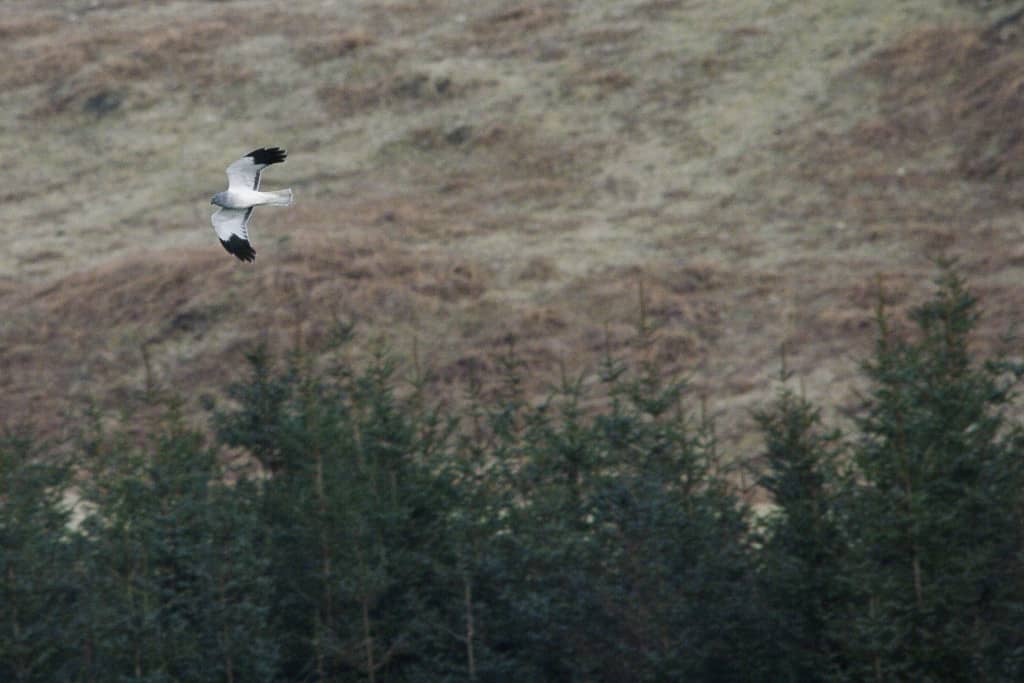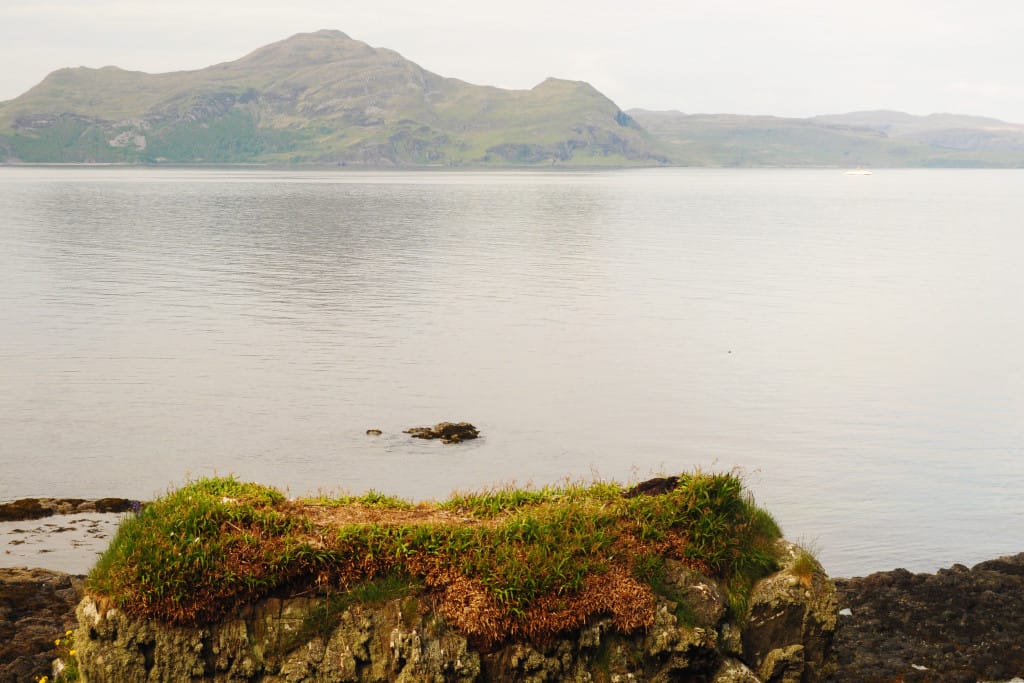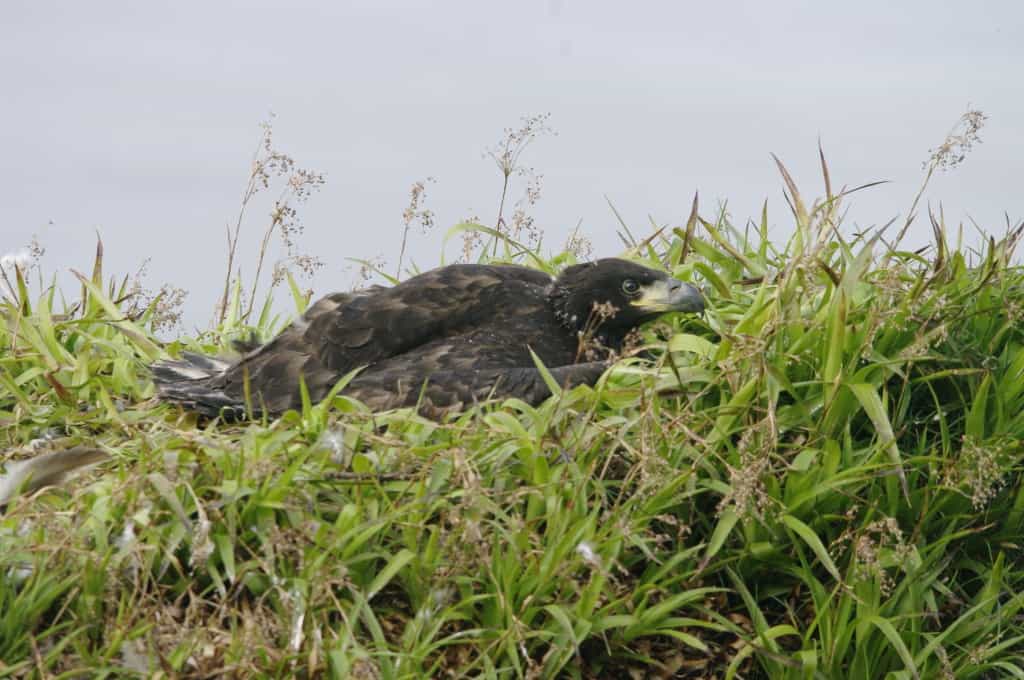It was early spring on ‘eagle island’ and on our marine excursions covering the north shore of Mull we were monitoring our local white-tailed eagle territory to see if nestingattemptswere taking place. After not seeing any clues in their traditional nest site high up in aconiferplantation, we noticed the female bird seemed to be hunkered down on aprominentsea stack at shore level. It was confirmed on the trip the following day that the eagles were incubating eggs on top of the exposed stack and we were even fortunate enough to view a change-over while sailing past later on in the week. This use of a nest site is known in Scandinavia where birds will nest on skerries, islets and stacks but it was a first record of its kind since the re-introduction of the birds to Scotland with chicks provided from Norway.
Both eagles are born and bred ‘Mulleachs’ with the male bird (wing tag blue X)fledgedfrom central Mull in 2002 and the female (green X) is a 2004 bird from the south east of the isle. They first raised a chick in 2010, failed in 2011 and produced two fledglings last year (2012). They had used the same nest site for all their breeding attempts which is a huge construction about 20 metres high in a sitka spruce plantation.

The sea stack is theremainsof a volcanic dyke (solidified lava flow) which stems away from an extinct super volcano on Ardnamurchan peninsula a few miles to the north. The stack is around 25 feet inheightwith a 20 foot width at the base and 15 feet at the top with agrassyoutcrop. Its location is quite exposed to westerly wind cycles which was the main concern for the birds’ parenting attempts this season.
Theneighbouringpair of golden eagles did not attempt to breed or had failed by the 17th April as bothbirds were seen away from the nest site for long periods. This could havepotentiallybeen to do with the very lowtemperaturesand the constant strong easterly winds which exposes the bay of the golden eagles. Across the sound of Mull to the north we monitored a golden eagle pair that got a chick away on the remote coastal stretch of Ardnamurchan. Going off the size of the eagles sat on top of the nest, we predicted the eyrie to be up to eight feet in depth.
Going inland to Mull’s moors and I spent my spring evenings observing the Hen Harriers around the north parts of the isle. Early concerns were the lowtemperaturesand slow progression of migrants arriving back on the moors with a very late spring taking place.In terms of food source there was a strong indicator of lack of voles on the isle with minimal sightings of short eared owls throughout the season. I went for two months from May to July without seeing one, and my last sighting on the north of the isle was the 5th May.
Iobserved some fantastic Hen Harrier behaviour including courtship bonding, display calling, copulation, sky dancing and interactions with grazing red deer near a nest site. One pair that I monitored actually nested on the same volcanic dyke remains in a young spruce plantation further inland from the north shore. The dyke goes in a south easterly direction for hundreds of miles all the way down to Derbyshire, extending even further than the Hen Harriers’ current breeding range in the UK. Work commitments cut my field sessions shorter in the summer months but I was informed that this pair laid 5 eggs and got at least two fledglings away.

In 2013 there were 18 proven breeding pairs of Hen Harrier, 2 probable breeding and two possible breeding attempts. Of the22 breeding attempts there was no evidence of actual nesting at 6 sites although food passes were observed. 12 nests were monitored with two failed on eggs and two failed with young 2+ weeks old. There were 8 successful nests with 18 fledged young. Thanks to Paul Haworth for providing this information from his fieldwork.
Back to the story of the stack and after some nasty spells of strong winds and persistent rain, the hardy eagles managed to hatch two chicks around the 1st May. By the 6th May there was only a single chick alive as we watched it grow on a daily basis and by the end of the month it had lost most of its down and was beginning to stand upright and work its wings to strengthen flight muscles. On the 4th June I was invited to observe the ringing of the chick. The first point of interest was the lack of nesting material used on the stack with only a few sticks at the most. The six week old chick was confirmed as a male bird and was in a healthy condition. The standout prey item for me was a number of dogfish sp intact on top of the stack. The small sharks are bottom dwellingspecialistsworking at depths of up to 1000m but come to shallows in the summer months to give birth, which is when the eagles will strike. Other prey items on the stack were gulls, auks, shags, rabbit, hedgehog, lamb and fish sp.

The chick made its first flight on the week 24th – 30th June and was the first fledged eagle of Mull on record in 2013. The bird naturally stayed close to the stack in the early weeks before edging further away from the territory. We watched a juvenile sea eagle catch a fish nearby on the 24th August which Ipresumewould be the stack bird but with no wing tags I cannot confirm this. BySeptemberonwards the fledged birddispersedfurther afield with only a couple of sightings of a juvenile sea eagle in the vicinity. The breeding white-tailed eagles on Mull produced 16 fledglings this season (2013) from around 16 active territories.

In October, myself and my dad were fortunate to see an amazing wildlife spectacle involving eaglebehaviour.We got onto a very high golden eagle coming overhead and a second bird appeared from the mountains. They suddenly started to drop quite low and when they got under the skyline you could get colouration on their plumage showing an adult bird and a second year bird. The adult bird dropped down to the ground flushing a very vocal first year bird which was sat on top of prey which looked like hare. The adult took flight with the prey in its talons and headed up the hillside as the second year bird followed on before they came together and the prey was exchanged on the wing! From what I understand an eagle food pass is seldom behaviour, and even more so that an adult wasservicinga second year bird.
There were 10 fledged golden eagle chicks this season (2013) on Mull which is about average compared to previous years on record. There are around 25 pairs of golden eagles on the isle and again their numbers have stayed constant in recent years. Thanks to Dave Sexton for providing the figures for Mull’s fledged eagles this year.
There are over sixty pairs of white-tailed eagles now in the west coast of Scotland and the re-introduction of the species has been a big conservation success story. There is still a long way to go until theycolonise their former range and take over all the remaining wild areas in Scotland and further afield. With proposed re-introductions of sea eagles lined up for Cumbria and Wales, wouldn’tit be great to see the king of birds ruling Britain’s skies once again.
Governmentpetitionto make the golden eagle the national bird of Scotland –
http://www.scottish.parliament.uk/GettingInvolved/Petitions/goldeneagle
e-petition -Licencing of upland grouse moors and gamekeepers –
http://epetitions.direct.gov.uk/petitions/46473
Ewan Miles
Ewan Miles is currently working on the isle of Mull for Sea Life Surveys as a wildlife guide. As well as trying to inspire passengers about the wildlife off the north coast of the island he also contributes to the research of the marine life. His local stomping ground is the vast upland area of Geltsdale, Cumbria in the Northern Pennines.
Leave a Reply